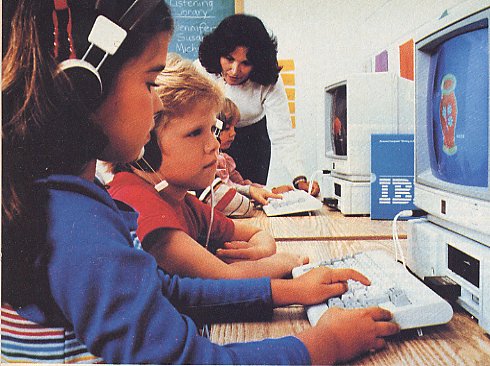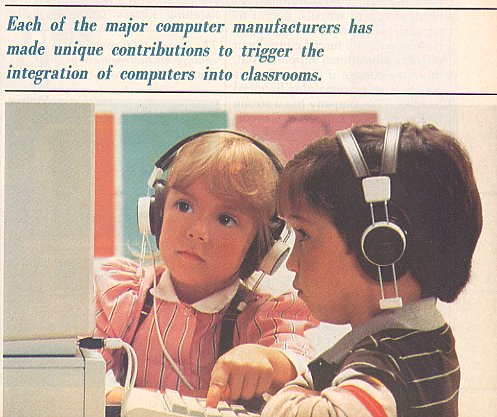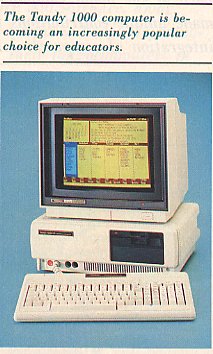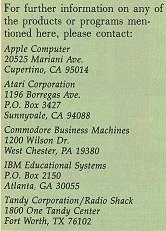Promoting Computers In School
Kathy Yakal, Assistant Features EditorVia free or discounted hardware and software, along with special teacher training, computer hardware manufacturers continue to promote their microcomputers in schools at every level. Here's an overview of recent efforts to increase the already impressive penetration of this technology into classrooms across the land.

Microcomputers now play a significant role in many areas of education. But getting computers into the classroom and deciding how they are best used continue to be subjects of much debate. A combination of factors has slowed the process even further: the problems of implementing a new, evolving technology; the chaotic atmosphere of the computer industry itself; the computer education of teachers and administrators; and the relatively tight budgets of educational institutions.
Nevertheless, tremendous changes have occurred in teachers attitudes toward microcomputers over the last couple of years. There are several reasons. First, software publishers have increasingly attempted to provide the kind of programs that teachers feel comfortable with—quantifiable, curriculum based software. At the same time innovative, nontraditional kinds of learning aids have gained a wider acceptance. Second, the hardware and software shakeouts that have moved the computer industry toward maturity and greater stability have made educators feel more confident about making a financial commitment to microcomputers. Finally, teachers are generally less anxious about computers and more experienced at applying them, with a growing number of classroom success stories fueling increased computer use. It's not just the students and a few computer-wise teachers who are driving the movement anymore.
Each of the major computer manufacturers has made unique contributions to trigger the integration of computers into classrooms. Some offer educational discounts. Others provide special grants and develop efficient ways to exploit the hardware, such as networking. In addition to easing the financial burden, hardware manufacturers promote the general health of the educational computing industry by fostering quality software development and encouraging nontraditional applications of hardware to traditional curricula. In-service training of teachers and special workshops sponsored by hardware companies have also been significant in creating a more upbeat attitude toward classroom computing in recent years.

Here's a company-by-company look at the variety of approaches.
Apple Computer
Officials at Apple Computer realized early on that a good software base was central to getting their hardware into schools. Apple made major efforts in the early 1980s to convince software developers to support its machines, offering them shared advertising, discounts on development machines, and technical support.
Currently, Apple has two educational discount programs. Step pricing gives buyers lower prices on larger orders, encouraging educators to buy in quantity whenever possible. And with the Volume Purchase Agreement, a school can elect to pay for its computers over a three-year time period. If a school involved in such an agreement finds that the hardware does not meet its needs, it may return the equipment without making the remaining payments.
Support after the sale is also a key to Apple's success in the school market. Apple relies heavily on its local dealers to provide on-site support to educators. Ten days before an order of computers is scheduled to reach a school, Apple notifies a local dealer who is then responsible for installing the equipment and providing orientation and training for teachers and administrators. The dealer is also responsible for any follow-up repair and maintenance.
Apple has developed a fairly high profile on many college campuses across the country, thanks to the Apple University Consortium (AUC). A couple of years ago, 24 U.S. colleges and universities formed an organization whose purpose was to develop tools and resources for the Macintosh. Because of that, many campuses today maintain busy Macintosh labs and workstations. At least one institution, Drexel University, requires its freshmen to purchase Macintoshes.
Atari Corporation
Atari Corporation's change of ownership and revamped management have resulted in few formal educational programs currently in operation. Considering Atari's growing strength, however, that may soon change. Low-cost 8-bit Ataris have already been the first kind of computer many students ever encountered in a class; their current availability and strong software base may even amplify this trend. And the low price of the powerful ST computers, as well as their strong graphics and music capabilities, may cause some educators to look twice, especially for use in creative applications.
Atari recently announced a marketing agreement with Montreal-based Arrakis, publisher of the Advantage series of educational software. ST versions of these programs, which have in the past been available for Apple, Commodore, and IBM, should be ready by the end of the year. The Arrakis series is known for its impressive graphics and cartoon-like animation, as well as a sophisticated parser which incorporates principles of artificial intelligence and provides direct answers to students' questions.

Computer Curriculum Corporation (Palo Alto, CA) has announced a commitment to Atari equipment. CCC is packaging STs along with their minicomputers and a series of courses; that is, they bundle hardware and software and install the complete systems in schools.
Finally, a 10-percent discount is available to colleges and universities, with follow-up service and support provided by local dealers.
Commodore
Commodore's big draw for schools lies in its inexpensive hardware and broad base of third-party educational software. Many teachers, unable to get funds allocated for major hardware purchases, started out by buying a few Commodore 64s (or even bringing their own in from home). In many settings, this was all that was necessary to get students familiar with the fundamentals of microcomputers, while also providing workstations for word-processing, database management, and computer-aided learning. In other cases, some school administrators have been willing to make a financial commitment to microcomputers in the classroom, based on the excitement they've seen generated by a few hundred dollars' worth of hardware and software.
Every major educational software publisher supports Commodore machines, so hundreds of titles have been developed for the Commodore 64 over the last few years. Though some are more appropriate for the less structured atmosphere of the home, many have been adopted for classroom use. A complete list of the more than 1500 packages will be available through distributors this fall.
Commodore has recognized that computer-aided education does not necessarily have to happen in a schoolroom, and has supported some unique opportunities for learning. Two of these involve telecommunications. Quantum-Link, a year-old service that Commodore has backed with technical and marketing assistance, is an online forum for sharing information of all kinds. Though much of the earliest activity that went on there was computer-oriented, a variety of other special interests are now supported there. Education is one of them. The Resource Center, a relatively new forum in the Learning Center area of Q-Link, is composed of three sections. The Library includes curriculum guides, teaching strategies, software reviews, and articles about home and community education. In the Media Room, users can download software written by teachers. The Lounge is an online conference area, a meeting place for teachers and parents to gather and discuss educational issues and plans. And the Resource Center's Message Boards keep everyone posted on what's happening in educational computing. (Quantum Computer Services, 8620 Westwood Center Dr., Vienna, VA 22180.)
Commodore is involved with another online educational venture: the Electronic University Network, operated by TeleLearning Systems, Inc., of San Francisco. By purchasing the $195 enrollment package, you have access to online courses offered by 25 colleges and universities. You may either take selected courses or, if you have met the school's prerequisites, work toward an M.B.A. or undergraduate degree. Degrees are issued by the schools involved, not by the Electronic University Network. The system software also gives you access to online databases—libraries of information for research purposes, as well as counseling and online seminars. (Software allowing IBM and Apple owners to use the network is also available. For more information, write to TeleLearning Systems, Inc., 505 Beach St., San Francisco, CA 94133, or call (800)22LEARN; in California, call (800)44LEARN.)
Commodore has, in the past, participated in more traditional outreach efforts to schools. Recent financial problems at the company have apparently forced cutbacks in ongoing educational support. That, too, may change if Commodore is able to weather remaining financial hurdles. The company has a strong history of major support to Canadian schools, and continues to maintain that presence.
IBM
IBM has made a major commitment to the basic skills of reading and writing with its Writing To Read program in the school market. Developed by educator Dr. John Henry Martin, Writing To Read was tested among 22,000 students and was evaluated in an independent two-year study by the Educational Testing Service before being introduced in the fall of 1984. The program has grown in use from 200 schools at the end of 1984 to 1100 schools at the end of 1985. More than 125,000 students have participated in the program. The computer-based program allows students to advance at their own pace and offers positive reinforcement during a student's interaction with the computer.
Through Writing To Read, children learn the 42 phonemes (letter and sound combinations) that make up the English language. Using these phonemes, students are able to read and write everything they can say. Typically, students spend an assigned hour each day in a Writing To Read center or lab, a specially designed room made up of five learning stations. Work sessions in the lab are generally an hour long. Students alternate around the five stations: at the computer, with a work journal, at a listening library using specially taped lessons, and playing two phoneme-based games at the "make word" station.
IBM has made a significant commitment to developing curriculum-based software in many subject areas for elementary and secondary schools, programs that come bundled with several student disks and a teacher's guide for easy use in classrooms with multiple computer workstations. Many of the programs are also available individually. In addition, IBM has founded the National Disability Resource Center, a national technology resource that supports the needs of the disabled.
Tandy Corporation/Radio Shack
The Tandy Corporation has had a longstanding commitment to computer use in the schools. In 1979, Tandy introduced the first low-cost classroom network system—Network 1. In 1980, the Radio Shack Education Division was formed to produce a line of educational courseware. In the years since, Tandy has offered free computer literacy training to teachers, provided formal support for educational software publishers, donated more than $1 million in hardware and software products to support research and development activities, and sponsored conferences and associations to promote the further integration of computers into classrooms.

Currently, three major programs are in place in addition to these areas of ongoing support. In conjunction with Education Systems Technology Corporation (ESTC), Tandy offers an integrated learning system for elementary schools, consisting of three major components: a comprehensive 1500-lesson reading and mathematics curriculum for grades K-6; a computer laboratory composed of Tandy 3000 host computer and up to 40 Tandy 1000 personal computer workstations, allowing an entire class to use the system at once; and an on-site facility management service, which includes an ESTC lab attendant and a complete computer-controlled student management and performance reporting system.
Tandy offers special pricing on educational network systems. Educational customers purchasing two Model 4 Computer/Network 4 Student Stations at the regular price of $1,099 each will receive a third station free. Other network configurations are available at substantial discount. Network 4 is Tandy's newest and most powerful classroom network. Students at individual stations can sign on to teacher-created network accounts to share software stored on the hard disk drives at a central disk server. The system supports multiple disk and printer servers, which saves money by eliminating the need for peripherals at each workstation. (This promotion is good through September 30,1986; interested customers may contact a Regional Education Coordinator by calling 800/433-5628.)
Finally, topics for the third and fourth quarter Grants Program have been announced. All nonprofit educational institutions and professional educators are eligible to submit proposals for these project grants. Proposals for "Creative Uses of Microcomputers in Education" should be submitted by September 30, 1986, and proposals for "Using Computers for Instructional Management" should be submitted by December 31, 1986. (Information packets required for use in order to submit proposals can be obtained by writing to Tandy Educational Grants Program, 1400 One Tandy Center, Fort Worth, TX 76102.)
